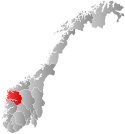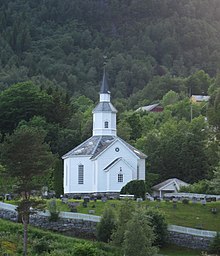Lavik
Lavik Municipality
Lavik herad | |
|---|---|
 View of the village of Lavik | |
 Sogn og Fjordane within Norway | |
 Lavik within Sogn og Fjordane | |
| Coordinates: 61°06′17″N 05°30′37″E / 61.10472°N 5.51028°E | |
| Country | Norway |
| County | Sogn og Fjordane |
| District | Sogn |
| Established | 1838-1861 |
| • Created as | Formannskapsdistrikt |
| Disestablished | 1 Jan 1964 |
| • Succeeded by | Lavik og Brekke in 1861 |
| Re-established | 1 Jan 1905 |
| • Preceded by | Lavik og Brekke in 1905 |
| • Succeeded by | Høyanger in 1964 |
| Administrative centre | Lavik |
| Area (upon dissolution) | |
| • Total | 220 km2 (80 sq mi) |
| Population (1964) | |
| • Total | 894 |
| • Density | 4.1/km2 (11/sq mi) |
| Time zone | UTC+01:00 (CET) |
| • Summer (DST) | UTC+02:00 (CEST) |
| ISO 3166 code | NO-1415[1] |
Lavik is a former municipality in the old Sogn og Fjordane (now Vestland) county, Norway. It was located in the western part of the present-day municipality of Høyanger, mostly on the northern side of the Sognefjorden. A small part of Lavik was located on the southern side of the Sognefjorden, a narrow strip of land running south around the Ikjefjorden, past the village of Øystrebø, all the way south to the border with Hordaland county. The municipality of Lavik existed from 1838 until 1861 and then again from 1905 until 1964. Upon its dissolution, the municipality was 220 square kilometres (85 sq mi). The administrative centre of the municipality was the village of Lavik where Lavik Church is located.[2]
Name

The municipality (originally the parish) was named after the old Ladvik farm (Old Norse: Lamvíkum), since Lavik Church was located there. The first element comes from the Old Norse word hlað which means "pile" or "load". The second element possibly comes from the Old Norse word víkr which means "inlet". Historically the spelling has varied greatly. It was Laduigh in the 16th century, Laduig in the 17th century, Ladvig in the 18th century, Ladevig in the 19th century, and finally Lavik in the 20th century.[3]
History
Ladevig (later spelled Lavik) was established as a municipality on 1 January 1838 (see formannskapsdistrikt law). In 1858, the district of Klævold was separated from Lavik to constitute a municipality of its own. The split left Lavik with 2,042 inhabitants. Klævold was later renamed Kyrkjebø. In 1861, Lavik (population: 926) was merged with the municipality of Brekke (population: 898), located on the south side of the Sognefjord, to form the new municipality of Lavik og Brekke.
On 1 January 1875, a part of Klævold with 90 inhabitants was moved to Lavik og Brekke. On 1 January 1905, the municipality was divided into two separate municipalities once again: Lavik (population: 1,182) and Brekke (population: 892). During the 1960s, there were many municipal mergers across Norway due to the work of the Schei Committee. On 1 January 1964, Lavik (population: 894) was merged with the neighboring municipality of Kyrkjebø (population: 4,742) and the unpopulated Nybø and Nygjerdet areas of Vik Municipality to form the new municipality of Høyanger.[4]
Government
Municipal council
The municipal council (Heradsstyre) of Lavik was made up of 17 representatives that were elected to four year terms. The party breakdown of the final municipal council was as follows:
| Party name (in Nynorsk) | Number of representatives | |
|---|---|---|
| Labour Party (Arbeidarpartiet) | 6 | |
| Liberal Party (Venstre) | 1 | |
| Joint List(s) of Non-Socialist Parties (Borgarlege Felleslister) | 8 | |
| Local List(s) (Lokale lister) | 2 | |
| Total number of members: | 17 | |
| Party name (in Nynorsk) | Number of representatives | |
|---|---|---|
| Labour Party (Arbeidarpartiet) | 5 | |
| Christian Democratic Party (Kristeleg Folkeparti) | 1 | |
| Farmers' Party (Bondepartiet) | 3 | |
| Liberal Party (Venstre) | 3 | |
| Local List(s) (Lokale lister) | 5 | |
| Total number of members: | 17 | |
| Party name (in Nynorsk) | Number of representatives | |
|---|---|---|
| Labour Party (Arbeidarpartiet) | 4 | |
| Liberal Party (Venstre) | 4 | |
| Local List(s) (Lokale lister) | 8 | |
| Total number of members: | 16 | |
| Party name (in Nynorsk) | Number of representatives | |
|---|---|---|
| Labour Party (Arbeidarpartiet) | 5 | |
| Liberal Party (Venstre) | 4 | |
| Local List(s) (Lokale lister) | 7 | |
| Total number of members: | 16 | |
| Party name (in Nynorsk) | Number of representatives | |
|---|---|---|
| Liberal Party (Venstre) | 4 | |
| List of workers, fishermen, and small farmholders (Arbeidarar, fiskarar, småbrukarar liste) | 5 | |
| Local List(s) (Lokale lister) | 7 | |
| Total number of members: | 16 | |
| Party name (in Nynorsk) | Number of representatives | |
|---|---|---|
| Labour Party (Arbeidarpartiet) | 4 | |
| Local List(s) (Lokale lister) | 12 | |
| Total number of members: | 16 | |
| Note: Due to the German occupation of Norway during World War II, no elections were held for new municipal councils until after the war ended in 1945. | ||
See also
References
- ^ Bolstad, Erik; Thorsnæs, Geir, eds. (2023-01-26). "Kommunenummer". Store norske leksikon (in Norwegian). Kunnskapsforlaget.
- ^ Store norske leksikon. "Lavik. – tidl. kommune" (in Norwegian). Retrieved 2014-01-17.
- ^ Rygh, Oluf (1919). Norske gaardnavne: Nordre Bergenhus amt (in Norwegian) (12 ed.). Kristiania, Norge: W. C. Fabritius & sønners bogtrikkeri. pp. 183–184.
- ^ Jukvam, Dag (1999). "Historisk oversikt over endringer i kommune- og fylkesinndelingen" (PDF) (in Norwegian). Statistisk sentralbyrå.
{{cite journal}}: Cite journal requires|journal=(help) - ^ "Kommunevalgene og Ordførervalgene 1959" (PDF) (in Norwegian). Oslo: Statistisk sentralbyrå. 1960. Retrieved 2020-02-16.
- ^ "Kommunevalgene og Ordførervalgene 1955" (PDF) (in Norwegian). Oslo: Statistisk sentralbyrå. 1957. Retrieved 2020-02-16.
- ^ "Kommunevalgene og Ordførervalgene 1951" (PDF) (in Norwegian). Oslo: Statistisk sentralbyrå. 1952. Retrieved 2020-02-16.
- ^ "Kommunevalgene og Ordførervalgene 1947" (PDF) (in Norwegian). Oslo: Statistisk sentralbyrå. 1948. Retrieved 2020-02-16.
- ^ "Kommunevalgene og Ordførervalgene 1945" (PDF) (in Norwegian). Oslo: Statistisk sentralbyrå. 1947. Retrieved 2020-02-16.
- ^ "Kommunevalgene og Ordførervalgene 1937" (PDF) (in Norwegian). Oslo: Statistisk sentralbyrå. 1938. Retrieved 2020-05-11.
External links
 Sognefjord travel guide from Wikivoyage
Sognefjord travel guide from Wikivoyage- Map of Lavik parish (roughly the same as the old municipality)

